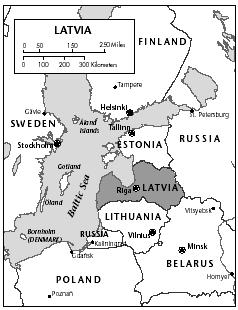Latvia - Political background
Latvia declared independence in November 1918 with the collapse of central authority in Russia and the defeat of the German army. In 1940, Latvia again fell under Russian rule, as the Union of Soviet Socialist Republics (USSR) annexed the country. The Republic of Latvia ceased to exist and was replaced by the Latvian Soviet Socialist Republic, a constituent union-republic of the USSR. The army of Nazi Germany invaded Latvia in 1941 and occupied it until 1945. These two brutal occupations resulted in the death of 180,000 people, or 9% of the pre-World War II Latvian population. To consolidate Soviet authority, Joseph Stalin deported or arrested 100,000 more people; 25,000 died in a war of resistance against the Soviet Union.
Under Communism, Latvian culture and other forms of national expression were repressed. Russified Latvians (some of whom spoke no Latvian), Russians, and others were dispatched to rule Latvia. In the post-Stalin era, dissidents who called for observance of human rights or religious rights, or who protested the repression of the Latvian nation were harassed, arrested, imprisoned, and sometimes killed.
Mikhail Gorbachev relaxed the controls on Soviet society, and many Latvians leaped at the opportunity. Various groups seeking greater local control sprang up. The most important of these groups, the Popular Front of Latvia (PFL) was formed in October 1988, marking a watershed in Latvian history. This broad-based movement provided organizational strength to harness the discontent with Soviet rule pervasive among Latvians and others.
A PFL slate of moderate nationalists won three-fourths of the Latvian SSR's seats in the USSR's newly created legislature in the March 1989 elections. The PFL grew increasingly radical in 1989, finally declaring itself in favor of eventual independence from the USSR. Throughout 1989 and 1990, in mass demonstrations and behind-the-scenes diplomacy, Latvian leaders pursued independence.
During the hard-line coup of August 1991 in Moscow, the leadership of Latvia quickly declared its opposition to the coup and support for Russian president Boris Yeltsin. The Latvian government declared the country independent on 21 August, insisting that the coup proved that there was no alternative. Once the Soviet Union crumbled, countries around the world recognized Latvia's independence.
In preparation for electing a new, post-independence legislature, the Supreme Council passed a citizenship law, but left key issues unresolved. Because of the fear of Russian domination and the fact that Latvians barely made up a majority of the country's population, Latvian leaders sought to write a citizenship law that ensured ethnic Latvian control over the fate of Latvia, while respecting the rights of others. Thus, the law they passed automatically granted citizenship to those who were citizens in 1940 and to their descendants. Others would be eligible for citizenship if they demonstrated proficiency in the Latvian language and if they have been residents for at least several years. The legislature did not, however, provide for a naturalization process, thereby leaving one-quarter of the population without citizenship.
Because of the difficulty involved in deciding on a citizenship law, elections for Latvia's first post-Soviet Saeima (Parliament) did not take place until June 1993. The results indicated that many voters supported the status quo and hoped to see a moderately paced transition in the economic realm.
Latvia elected a new Saeima in the fall of 1995. Latvia's voters showed themselves clearly divided, electing a parliament so evenly divided on core issues that selecting a government took months. Conservatives favored closer ties with the West and opposed weakening the citizenship laws. Liberals argued for improving relations with Russia and easing naturalization rules. This situation left two extremist parties—one on the left and one on the right—holding the

balance of power at the margins. Just before Christmas, the Parliament approved a broad-based coalition cabinet. Andris Shkele, a businessman and former government official, agreed to lead a cabinet that included every party in the Saeima, except the extremist Socialists and People's Movement.
Shkele proved an effective leader. He forced through the unpopular spending cuts and tax increases that were necessary to balance the budget. He accelerated economic reform. His abrasive style and unpopular policies, however, forced him to resign in January 1997. The president renominated Shkele, and he won with overwhelming support in the Saeima. He continued as prime minister until his coalition collapsed in July 1997.
Latvia's economy suffered terribly in 1998. Russian purchases of Latvian goods and services declined precipitously, causing Latvia's economy to contract, increasing the trade imbalance and unemployment rate. In June 1998, the Saeima, acting at the behest of the European Union (EU), approved amendments to the citizenship law, easing requirements for obtaining citizenship.
At the same time, parliamentary elections resulted in Shkele's People's Party winning a plurality of the vote. Because Shkele was so reviled by other politicians, however, three smaller parties, with the acquiescence of a left-wing party, were able to form a minority government without Shkele in November 1998. A new president was elected by the Saeima on 17 June 1999. Vaira Vike-Freiberga was inaugurated as Latvia's first female president on 8 July 1999.
Comment about this article, ask questions, or add new information about this topic: